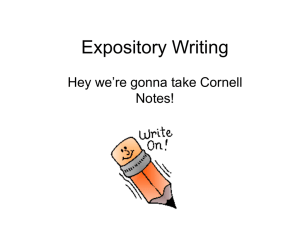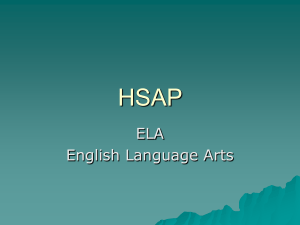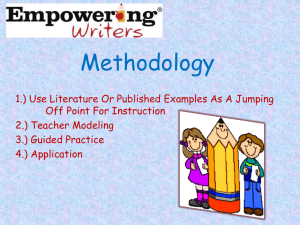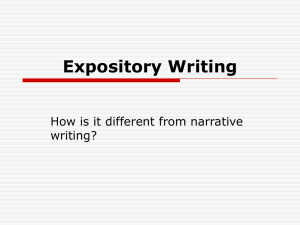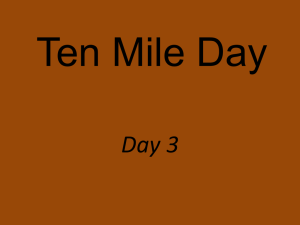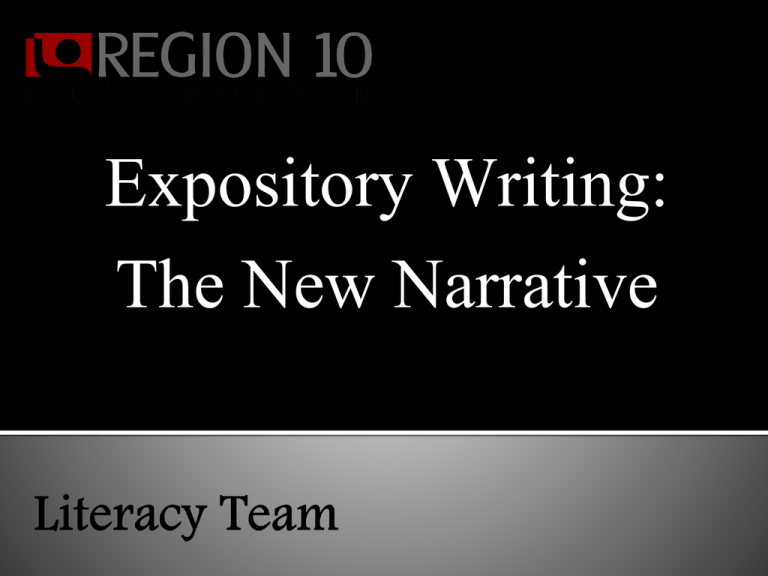
Expository Writing:
The New Narrative
The ELAR TEKS require students to “write expository texts to
communicate ideas and information to specific audiences for specific
purposes.” To help students move beyond writing the typical narrative
texts, teachers must provide students with opportunities to write in a
variety of genres…especially expository. During this workshop,
participants will identify how the standards address expository writing,
familiarize themselves with samples of expository mentor texts, review
mini lessons to implement expository writing in their classrooms, and
sample lessons on teaching expository writing.
Housekeeping
• Restrooms
• Cell Phones
• Snacks
-gazing can get out of hand.
A text message?
A social media post?
A letter?
A description?
A referral?
A lesson plan?
A review?
An email message?
A thesis paper?
Directions?
Grade 4
Personal Narrative
Expository (not “how to”)
Grade 7
Narrative with Extension
(extension weaved into
writing; not added at the
end)
Expository
English I
Expository
English II
Persuasive
English III
Analytic
Literary Strand
Fiction Readiness Genre
Literary Nonfiction
Poetry Supporting Genre
Drama Supporting Genre
Supporting Genre
Assessed beginning at 4th grade
Media Literacy
Embedded
Informational Strand
Expository Readiness Genre
Persuasive Supporting Genre
Assessed beginning at 5th grade
Procedural
Embedded
Media Literacy
Embedded
Form/Content
Sub-Genre
Biography
Literary Nonfiction
Speech
Literary Non-fiction / Persuasive
Informational Chart
Media
How-to
Procedural
Picture with Caption
Media
Letter of Complaint
Expository
Play about a true story
Drama
Thank-you note
Expository
Folk Tale
Fiction
Letter to Influence Attitudes
Persuasive
Story about a boy and his dog
Fiction
STATE OF TEXAS ASSESSMENTS OF
ACADEMIC READINESS (STAARTM)
Grades 3−8 Reading
Grades 4 and 7 Writing
English I, II, and III
Victoria Young
Director of Reading, Writing, and
Social Studies Assessments
Texas Education Agency
STAAR Writing Rubric
20
Score Point 1—VERY LIMITED
Score Point 2—BASIC
Score Point 3—SATISFACTORY
Score Point 4—ACCOMPLISHED
Teachers and students need to have an
in-depth understanding of the writing
rubric for each type of writing!
Writing Scoring Model for STAAR
21
Rubrics
Summed Scores
Weighting
Rubrics (used in conjunction with student
responses representing each score point)
are the basis for assigning scores
Two readers score each student writing
response. If there is perfect or adjacent
agreement, the two readers’ scores are
summed.
Summed scores range from 2−8
(0 = nonscorable)
Scoring Model for STAAR
22
SUMMED
SCORE 1 SCORE 2 SCORE
0
1
1
2
2
3
3
4
0
1
2
2
3
3
4
4
0
2
3
4
5
6
7
8
CSR RATING
Nonscorable Performance
Very Limited Performance
Between Very Limited and Basic Performance
Basic Performance
Between Basic and Satisfactory Performance
Satisfactory Performance
Between Satisfactory and Accomplished Performance
Accomplished Performance
“You've got to think about this
as a continuum. What we're
trying to do with summing is
to pinpoint more accurately
where the kid is on this
writing continuum."
23
READ: A short synopsis of some kind or a quote.
THINK: The synopsis or quote generalized and
reworded
WRITE: An even more focused rewording
BE SURE TO: A reminder to proof
Do you have a thesis statement?
Did you find it harder or easier to write in
expository mode?
Did you drift into a narrative?
Could your essay fit onto the 26-lined page?
Expository and Literary
Highlight the
most important
words or phrases
Record key,
recurring
words for these
score points
Work with your team to
create main idea statement about
these three categories in 10
words or less.
Grades K – 12, Writing Process: Students use elements of the
writing process (planning, drafting, revising, editing, and
publishing) to compose text.
Grade K-12: Writing/Expository Texts. Students write expository
[and procedural or work-related] texts to communicate ideas and
information to specific audiences for specific purposes.
Grade 7: (17) Writing/Expository Texts. Students write expository
[texts to communicate ideas and information to specific audiences
for specific purposes. Students are expected to write a multiparagraph essayto convey information about a topic.
Jim Burk said. . .
“One cannot develop such intelligence by
osmosis; instead, it requires deliberate
instruction. Writing is often assigned, but if
students are to master this complex craft, it
must be taught.”
(2009) Burke, Jim. Content Area Writing. New York, NY Scholastic
Putting it into practice
Take a piece of chart paper and markers
Divide the paper up in four parts
Label each part with the following:
Books
Television shows
Movies
Songs
Bridge to Terrabithia
Lean On Me - Bill Withers
Harry Potter
The Golden Girls
List the main characters from the books,
movies, TV shows and songs just
brainstormed
Discuss the qualities of friendship the
characters show
Independently, come up with 3 – 5
characteristics that you think is most
important
Encouraging / supportive
Honest
Challenges me
Holds me accountable
Watch as I model how I would begin this
piece of writing.
READ the following quotation.
“A friend is one that knows you as you are, understands
where you have been, accepts what you have become,
and still, gently allows you to grow.”
- William Shakespeare
THINK carefully about the following statement.
Friendships are important, but everyone has a different opinion of the
qualities of a friend.
WRITE an essay explaining what makes a person a good friend.
Be sure to –
Clearly state your controlling idea
Organize and develop your explanation effectively
Choose your words carefully
Use correct spelling, capitalization, punctuation, grammar, and
sentences
Text Structures
Pattern
Description
Cue Words
Description
The author describes a topic by listing
characteristics, features, and examples
for example, characteristics are. . .
Sequence
The author lists items or events in
numerical or chronological order.
first, second, third; next; then; finally
Comparison
The author explains how two or more
things are alike and/or how they are
different.
different; in contrast; alike; same as;
on the other hand
Cause and Effect
The author lists one or more causes and reasons why; if...then; as a result;
the resulting effect or effects.
therefore; because
Problem and
Solution
The author states a problem and lists one problem is; dilemma is; puzzle is
or more solutions for the problem. A
solved; question... answer
variation of this pattern is the questionand-answer format in which the author
poses a question and then answers it.
Stanford University: http://www.stanford.edu/~arnetha/expowrite/info.html
Predetermined number of
paragraphs
Student choice
Text Structures
Pattern
Description
Cue Words
Description
The author describes a topic by listing
characteristics, features, and examples
for example, characteristics are. . .
Sequence
The author lists items or events in
numerical or chronological order.
first, second, third; next; then; finally
Comparison
The author explains how two or more
things are alike and/or how they are
different.
different; in contrast; alike; same as;
on the other hand
Cause and Effect
The author lists one or more causes and reasons why; if...then; as a result;
the resulting effect or effects.
therefore; because
Problem and
Solution
The author states a problem and lists one problem is; dilemma is; puzzle is
or more solutions for the problem. A
solved; question... answer
variation of this pattern is the questionand-answer format in which the author
poses a question and then answers it.
Stanford University: http://www.stanford.edu/~arnetha/expowrite/info.html
Who is this special person?
What makes this person special?
Note - encourage students to go beyond he/she is
nice, fun, great, etc. Ask questions like: What makes
her great? What does she do to show you that she’s
nice?
Possible Structure: Compare/Contrast
Other Family
Members
Andrea
Lets me into
Kick me out of
her room even
their rooms
If she is busy
They all love me
Will not take me
She will take me
anywhere
I love them
places if I tell her
ahead of time
Won’t watch TV
Very busy
or play games with
Watches TV &
me unless it’s what
plays fun games
they want
with me
I am the baby of five children in my family. Yep, that’s right! There
are seven people in my house! Even though we all love each other very
much, everyone is always too busy for me. My sister, Andrea, is special
because she’s the only one in my family who makes time for me.
When I go to my older brothers’ rooms, I barely get one pinky toe
in before they say, “Get out!” They say they are all doing things and
they don’t want me in there to ask a lot of questions. This doesn’t
happen when I go to Andrea’s room. She tells me to come on in. Even
if she is on the phone or reading, she does not mind if I come in and
sit on her bed. She will even let me ask a few questions without getting
mad at me.
My parents work a lot, so they cannot always take me to soccer
practice or to programs I have to go to at school. But since Andrea got
her license, she will take me to practices and even to my friend’s
birthday party if she can…
Possible Structure: Cause-Effect
Before Joel came
to our school, I
didn’t have any
friends. I used to
sit by myself in
the cafeteria.
People didn’t pick
me for teams in
P.E. I was quiet
because I did not
know anyone.
Joel’s family moved right next door.
We started playing together right
that weekend. When school started
Monday, we started being friends at
school. Now, I always know I have
someone to sit next to who will
actually talk to me. A lot of people
like Joel, so it’s kind of like they talk
to me because he’s my friend, too.
Joel is special because if it weren’t
for him, I would still feel all alone at
school.
Possible Structure: Logical
Many people go to work every day, but not everyone can say
that they are keeping the city safe. My father is special
because he risks his life to help other people.
He faces danger every day on his job. He is a police officer…
His job as an officer never stops. Even when he is not at
work, he knows that he has a duty to people no matter
where he goes. For example, one time when we were at a
baseball game, …
Most people do anything they can to stay our of harm’s way. My
dad is special because he does just the opposite every day.
Specific or concrete
examples
Facts
Self-evident truths
Anecdotes
Comparisons or
analogies
Authoritative quotes
or testimonials
Numbers/statistics
Descriptive details
Definition
Graphics (diagrams,
maps, charts, etc.
Using the Time for Kids Articles, Identify
Text Structures, Transitions and Details
“Reading and analyzing expository literature
with your students, as an isolated practice,
will not advance their writing skills. The
exercise must be part of an ongoing
classroom writing workshop.”
Jim Burk said. . .
“The complexity of the writing process, which
consists of both cognitive and emotional
elements, can leave even the strongest teacher
feeling ineffective, unsure of where to begin or
how to proceed.”
(2009) Burke, Jim. Content Area Writing. New York, NY Scholastic
•26 lines
•Using the TAKS writing samples, work with
your group to rewrite the samples so that they
are no more than 26 line.
The ELAR TEKS require students to “write expository texts to
communicate ideas and information to specific audiences for specific
purposes.” To help students move beyond writing the typical narrative
texts, teachers must provide students with opportunities to write in a
variety of genres…especially expository. During this workshop,
participants will identify how the standards address expository writing,
familiarize themselves with samples of expository mentor texts, review
mini lessons to implement expository writing in their classrooms, and
sample lessons on teaching expository writing.
The Evolving
Publishing
Industry
Compare-Contrast selfpub and traditional
because two are both
prevalent
Sequence – show the
process
FAQs – discuss some issues
that didn’t get covered in
the earlier portions
Natural Hair
Care
The Fine Art
of Being a
Wife
Gives students the opportunity practice
forming/evaluating central ideas and
supporting evidence.
Each table gets a laminated “placemat”
big enough for 4 people to write on and
easily rotate
Each person will need a dry-erase
marker
In a moment, we will write the key
words from a prompt in the center
circle
Each person forms a central idea
statement and places it on the placemat
Table turns the placemat
Next person must give one supporting
statement under another person’s central idea
Table turns the placemat
Repeat
Modeling Time!
Should toymakers create overweight dolls?
Literacy Team
Jayne Knighton, M.Ed.
ELA Program Coordinator
jayne.knighton@region10.org
972-348-1444
Robyn Fox, M.Ed, MRT
K - 12 Consultant specializing in
Primary / Elementary School
robyn.fox@region10.org
972-348-1484
Virginia Gonzalez, M.Ed., LDT, CALT
State Dyslexia Consultant
virginia.gonzalez@region10.org
972-348-1410
Nancy McGruder, M.Ed.
K - 12 Consultant specializing in
Intermediate / Middle School
nancy.mcgruder@region10.org
972-348-1404
Gina Mitchell, MLA, LDT, CALT
Regional Dyslexia Consultant
gina.mitchell@region10.org
972-348-1454
Terry Roper, M.L.S.
K - 12 Consultant specializing in
Library Science
terry.roper@region10.org
972-348-1414
Kay Shurtleff, M.A.
K - 12 Consultant specializing in
Middle / High School
kay.shurtleff@region10.org
972-348-1756
Joan Vaughan, M.Ed
K - 12 Consultant specializing in
Middle / High School
joan.vaughan@region10.org
972-348-1520
Region 10 Education Service Center
It is the policy of Region 10 Education Service Center not to
discriminate on the basis of race, color, national origin, sex or handicap
in its vocational programs, services or activities as required by Title VI
of the Civil Rights Act of 1964, as amended; Title IX of the Educational
Amendments of 1972; and Section 503 and 504 of the Rehabilitation
Act of 1973, as amended. Region 10 Education Service Center will take
steps to ensure that lack of English language skills will not be a barrier
to admission and participation in all educational programs and
services.

